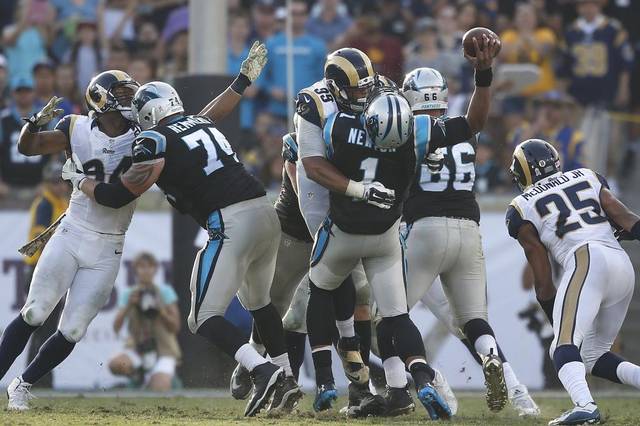No matter how many “player safety” changes the league tries to lard-up the rulebook with, there is no way to escape the hard cold truth of athletic progress. Bigger faster players, who are also more athletic, will keep colliding with each other at a completely unsafe rate of speed and force.
So of all the awesome highlights from this past weekend in the NFL, this one is my favorite. Rams All-World DT Aaron Donald, sheds his block, and then breaches like a great white shark, to swallow Cam Newton like a guy sitting in a rowboat.
How impressive is it that Cam Newton DID NOT fumble on this leaping sack by Aaron Donaldhttps://t.co/CqJcYwD5qS
— Jason McIntyre (@jasonrmcintyre) November 6, 2016
And yes, I am aware. There was helmet to helmet touching. It was not rules a penalty, and should not have been. Just like the Mark Barron sack of Cam Newton earlier in the game.
Cam Newton takes a VICIOUS SHOT!!! #CARvsLA pic.twitter.com/9q8EXkBegc
— History Of Sports (@BeforeFamePics) November 6, 2016
Barron comes shooting through the line on a blitz, and closes on Cam at warp speed. He braces for an upright shoulder to shoulder hit, when Cam suddenly crouches at the last minute, bringing the side of his own helmet right down into the “strike zone.”
Cam was sacked 5 times, knocked down 12, and there were no penalties. So much for that call to Goodell, eh Cam?
Of course my title to this post is facetious. Nobody wants to ban awesome apex-predator athletes like Aaron Donald. However, I have said for a while now that the NFL should seriously study the concept of “weight limits” by position.
Donald is listed at 6-0, 284.
You could mandate that d-linemen weigh no more than 250, o-line (let’s give ’em a slight advantage) 260, and pick your preferred number for every other position on the team.
Sure, it would be a logistical challenge to make sure every player on your team “made weight” from week to week during the season. But it’s surely do-able.
And no, it wouldn’t eliminate injuries entirely, but it would dial down the bone-breaking violence of what the league has become through better training and football evolution.
Here’s the average o-line player by decade.
1920’s – 6’0″ – 211
1930’s – 6’1″ – 220
1940’s – 6’1″ – 221
1950’s – 6’2″ – 234
1960’s – 6’3″ – 251
1970’s – 6’3″ – 255
1980’s – 6’4″ – 272
1990’s – 6’4″ – 300
2000’s – 6’4″ – 313
2010’s – 6’5″ – 310
When I was a kid, I marvelled at the concept of “Demolition Derby’s.” What I didn’t understand, however, was how come more driver’s didn’t DIE crashing into each other.
It took my Uncle Tom (who would race dirt track cars in upstate New York) to explain it to me that the Demo Derby cars are hollowed out of everything but the engine and cage. And the fact that they are in a confined space, running on dirt (where traction is 50% of pavement), there’s not nearly as much lethal force in play.
The NFL was once a dirt-circle demo derby, but now it’s like running fully souped up 18-wheel rigs on dry pavement.
You can beef up helmets all you want, you can add layer and layer of rules until we’re all throwing our remotes at the televisions.
But in the end, force still equals MASS times acceleration. And since limiting acceleration seems impossible to me, player mass is the only thing left to regulate.





I believe if you got rid of stoppages in hoops guys like Shaq, Yao, and Adams would not even get drafted. Guys like Iverson and Westbrook would average 40.
You tell your dad to drag Walton and Lanier up and down for 48 minutes.